6e
BPC, "Opération
Castor"
Dien Bien Phu Novembre 1953
Rolling
Thunder French Indochina war
studies for re-enactors
The
newly formed Indochina Living
History section of Rolling
Thunder have done some specific photo
shoots
for uniform studies.
This
study will give you a brief
description of the unit and its involvement
in the Indochina war
with some war time photos and
links as well as re-enacted
photos.
A full description of uniforms and
equipment used by this unit is also
included.
The
French paratroopers in Indochina
were the post-WWII elite forces
of the French army. They were
used as firemen for the
Indochinese theatre and wherever
a situation needed sorting out, they
were engaged.
As Elite troops,
their uniform was always quite
distinctive from the other
French troops and evolved
quickly
during the war. French paratrooper uniforms worn
during that famous battle were
quite varied
but helped us to
identify the unit represented.
|
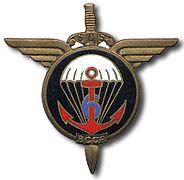
6e
Bataillon
Parachutistes
Coloniaux,
6e BPC
The
battalion
was created
in Brittany
in 1948
under the
designation
of 6e BCCP (bataillon
colonial de
commandos
parachutistes) and trace
its lineage
to WWII
French SAS.
It arrived in
Saïgon
in 1949
and was
rename the
6e GCCP (groupement
colonial de
commandos
parachutistes)
on the 1st
of Octobre
1950, then
6e BPC (bataillon
parachutistes
coloniaux)
on the 1st
March 1951.
The battalion
was dissolved
on its
return to
France on the 20
August 1951 and
then
reformed in
1952 to
return to
Indochina.
The battalion
was dropped
on DBP
during
operation
Castor on
the 20th
November.
Them for a second
time over
DBP on the
16th of
March 1954
and
fought in
the valley until
its
destruction on the 7th
May
1954.
6e BPC is
one of the
most famous
French
Airborne battalion
and was
commanded by
one of
France most
known and
decorated
general,
Marcel
Bigeard
"BRUNO"
and was
often referred
as Bigeard's
battalion.
"Operation
Castor"
Dien Bien Phu
Opération
Castor was
the French
airborne
operation to
established
a fortified
air-land
base at
Dien Bien
Phu, an old
airstrip
built by the
Japanese during their 1940-45 occupation.
Commanded by
Brigadier
General Jean Gilles, Castor was the largest
airborne
operation
since World
War II. The
Operation
began on
20 November
1953
, with
reinforcements
dropped over
the
following
two days.
With all its
objectives
achieved,
the
operation
ended on 22
November.
The
French paratroopers of the
6ème
Bataillon de
Parachutistes
Coloniaux (6ème
BPC
) and the
2nd
Battalion of
the 1er Régiment de Chasseurs Parachutistes
(II/1er RCP)
dropped over
Dien Bien
Phu and the
operation
took 65 of
the 70
operational Dakota and all 12 C-119 Flying Boxcar transport aircraft the
French had
in the area
and still
required two
trips to get
the lead
elements
into the
valley. Also
dropped in
the first
wave were
elements of
the 17e Régiment de Génie Parachutiste
(RGP)
(“17th
Airborne
Engineers
Regiment”)
and the
Headquarters
group of
Groupement Aéroporté
1
(GAP
1),
(“Airborne
Group 1”).
They were
followed
later in the
afternoon by
the 1er
Bataillon de
Parachutistes
Coloniaux (1
BPC
) and
elements of
35e Régiment d’Artillerie Légère
Parachutiste
(35 RALP)
and other
combat
support
elements.
The
following
day, the
second
airborne
group, (GAP
2) –
consisting
of 1er Bataillon Etranger de Parachutistes
(1 BEP), 8e
Bataillon de
Parachutistes
de Choc (8
BPC
), other
combat
support
elements and
the entire
command and
Headquarters
group for
the Dien
Bien Phu
operation
under
Brigadier
General Jean
Gilles were dropped
in. The
heavy
equipment
came down pm
another drop
zone and the
engineers
quickly set
about
repairing
and
lengthening
the old airstrip.
On
22 November,
the last
troops the
5e Bataillon de Parachutistes Vietnamiens
(“Battalion
of
Vietnamese
Parachutists”,
5 BPVN),
jumped into
the valley.
In the same
“stick”
as the
commander of
5 BPVN was Brigitte Friang, a woman war correspondent with
a military
parachutist
diploma and
five combat
jumps.
General
Navarre
created the
outpost to
draw the
Viet Minh
into
fighting a
pitched
battle. That
battle,
occurred
four months
after
Operation
Castor and
ended up in
a defeat for
the French
on
the 7th of
May 1954
after
massively
under
estimating
the Viet
Minh forces
and
capabilities.
The Battle of Dien Bien Phu did cost the CEFEO over
3,000 men,
1,700 dead
and 1,600
missing;
4,400 French
soldiers
were
wounded;
10,300,
including
the 4,400
wounded,
were taken
prisoner.
The enemy
lost at
least 8,000
men and had
over 15,000
wounded.
The Viet
Minh’s
victory in
Dien
Bien Phu
heralded France
's withdrawal from Indochina.
The Geneva
Agreements
of
21 July 1954
brought an end to the First Indochina War and
recognised
the
democratic
government
of Vietnam.
Out of the
10,300
French
soldiers
taken prison
in
Dien
Bien Phu
, only 3,300 were returned to their families. The
others lost
their lives
along the
roads that
took them to
the Viet
Minh
detention
centres or
camps were,
they were
left without
any medical
treatment,
exhausted,
starved or
were
summarily
executed.
***
6e
BPC, Operation
Castor 20th
November 1953
Setting
the scene
At
10.30 on
the 20st of
November 1953 during
Operation Castor, the 6e BPC was
dropped as part of the 1st wave of French
paratroopers into the
valley of Dien Bien Phu. The
objective was to secure a
WWII-era landing strip and to later
construct a fighting camp
to draw the Viet Minh into
another pitched battle against a
well-defended position (similar scenario
to Na San). Once
on the
ground the
6e BPC ran into
contact with the
Viet Minh 910th
Battalion, 148th
Regiment, which
was conducting
field exercise
in the area
along with a
battery from the
351st Artillery
Division
and an
infantry company
of the 320th
Division.
Fighting
persisted until
the afternoon
when the Viet
Minh units
eventually
withdrew to the
south.
The 6e BPC (450 men
strong which
included 200
Vietnamesse) was dropped as
re-enforcement
in DBP on the
16th of March
and operated from the
central position
"Claudine" as
general reserve
for counter
attacks,
unfortunately
its strength was
quickly eroded
after bloody
assaults
to re take
fallen
positions.
The
battalion saw
its destruction
with the rest of
the garrison on
the 7th May
1954.
Re
enacted photos
are from HQ company
showing
an Officer,
a Radio and a NCO in
the valley
towards the end
of the first day
of
"Operation
Castor".
 A
10h30 le
20
novembre
1953
lors de
l'opération
Castor,
le 6e
BPC fut
largué
avec la
1ère
vague de
parachutistes
français
dans la
vallée
de Dien
Bien Phu.
L'objectif
était
de sécuriser
une
ancienne
piste
d'atterrissage
de la
Seconde
Guerre
mondiale
et de
construire
plus
tard un
camp
retranché
pour
attirer
le Viet
Minh
dans une
autre
bataille
contre
une
position
bien défendue
(un
deuxième
Na San).
Une
fois au
sol, le
6e BPC
est entré
en
contact
avec le
148e régiment
du 910e
bataillon
Viet
Minh,
qui
menait
des
exercices
sur le
terrain
avec une
batterie
de la
351e
Division
d'artillerie
et une
compagnie
d'infanterie
de la
320ème
Division. A
10h30 le
20
novembre
1953
lors de
l'opération
Castor,
le 6e
BPC fut
largué
avec la
1ère
vague de
parachutistes
français
dans la
vallée
de Dien
Bien Phu.
L'objectif
était
de sécuriser
une
ancienne
piste
d'atterrissage
de la
Seconde
Guerre
mondiale
et de
construire
plus
tard un
camp
retranché
pour
attirer
le Viet
Minh
dans une
autre
bataille
contre
une
position
bien défendue
(un
deuxième
Na San).
Une
fois au
sol, le
6e BPC
est entré
en
contact
avec le
148e régiment
du 910e
bataillon
Viet
Minh,
qui
menait
des
exercices
sur le
terrain
avec une
batterie
de la
351e
Division
d'artillerie
et une
compagnie
d'infanterie
de la
320ème
Division.
Les
combats
ont
persisté
jusqu'en
après-midi,
lorsque
les unités
du Viet
Minh se
sont
finalement
retirées
vers le
sud.
Le
6e BPC
(450
hommes,
dont
200
Vietnamesse)
a
ressaute
sur
DBP EN
renfort
le 16
mars
1954.
Il a
opéré
à
partir
de la
position
centrale
"Claudine"
comme
réserve
générale
pour
les
contre-attaques,
malheureusement
sa
force
s'est
rapidement
érodée
après
des
assauts
sanglants
pour
reprendre
des
positions
perdues.
Le
bataillon
fut détruit
avec
le
reste
de la
garnison
le 7
mai
1954.
Photos
de
reconstitution
de la
compagnie
de
commandement
montrant
un
officier,
un
sous
officier
et un
radio
dans
la
vallée
vers
la fin
du
premier
jour
de
l'Opération
Castor.
(Excusez
les
bottes
Italiennes)
(Reconstitution
faite
par
Rolling
Thunder,The
Vietnam
Experience
dans
le sud
de
l'Angleterre
durant
Military
Odyssey,
Aout
2017)
|
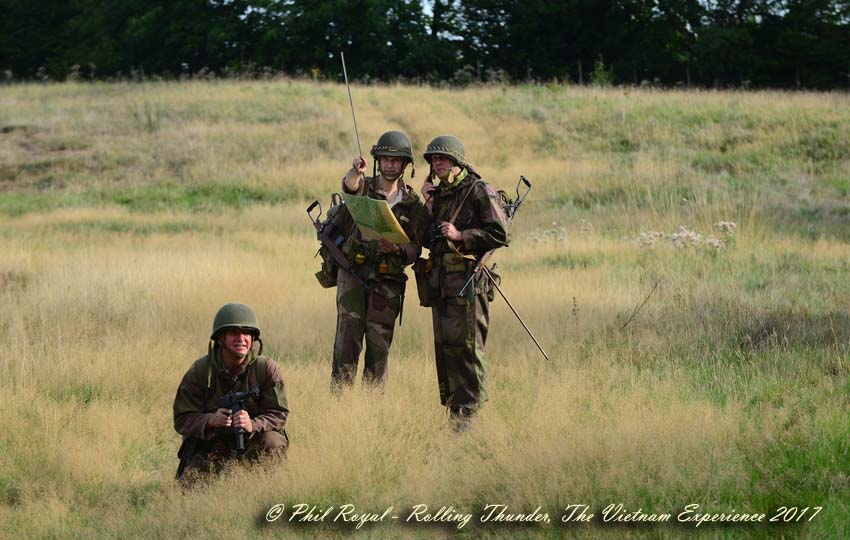
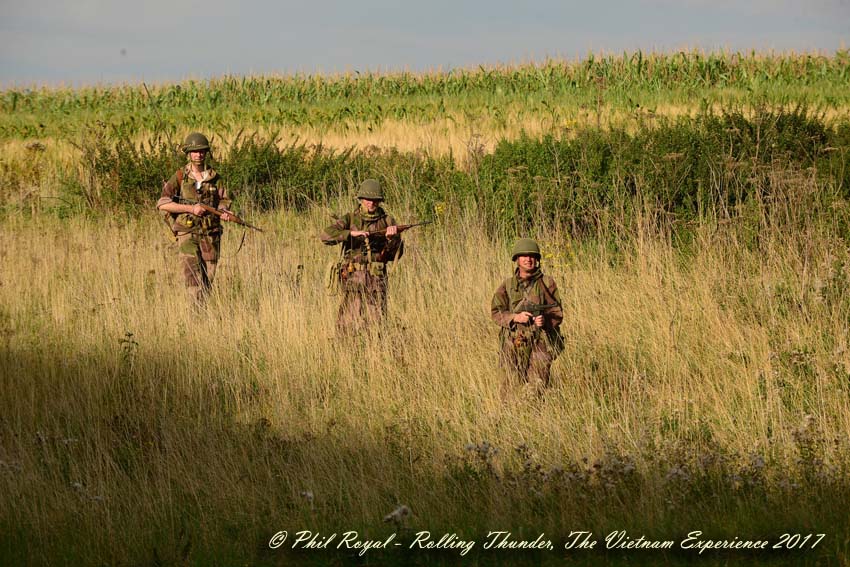
***
We
are on the
second day of
Operation
Castor, the
combat have
ceased with the
Viet Minh
disappearing towards
the South of the
valley and the new Bigeard cap
have now replaced
the helmets!
The
men from HQ
company are
orgenising the drop zones
for the second phase
of the operation:
the drops of the
second airborne
group, "GAP
2" in the
Dien Bien Phu
valley.
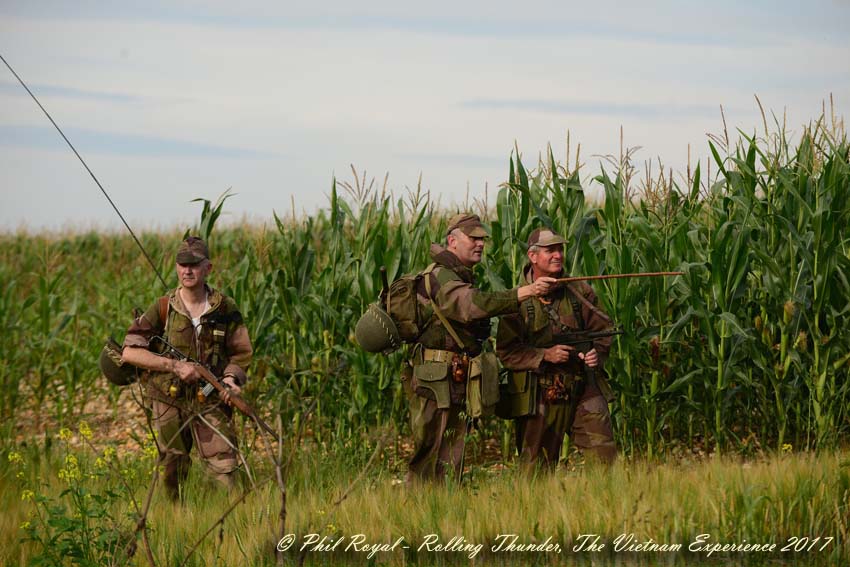
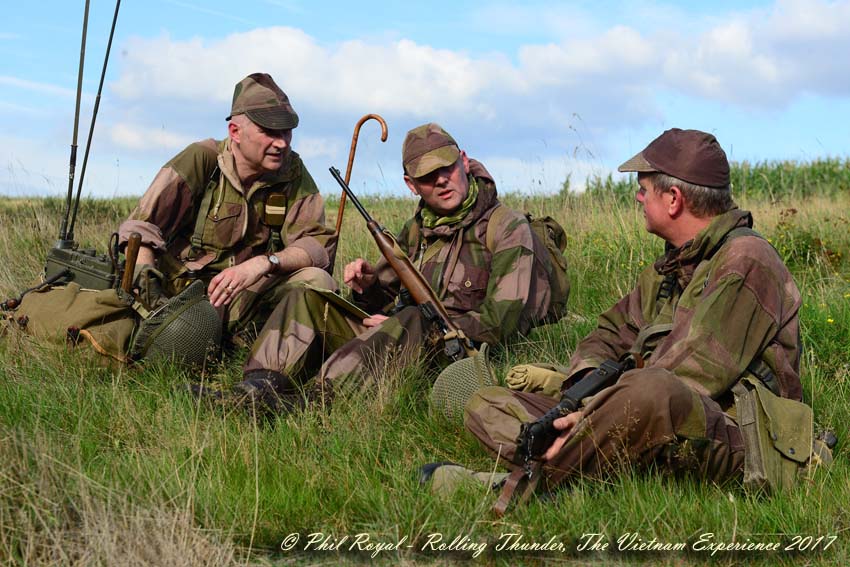
Bamboo
canes were often
carried by
company commanders
or platoon
leaders
"GAP
2 are been
dropped",
no
marker was
available on this
small secondary
DZ, so an old
Tricolor was got
out of one of the ruck
to mark current
position!
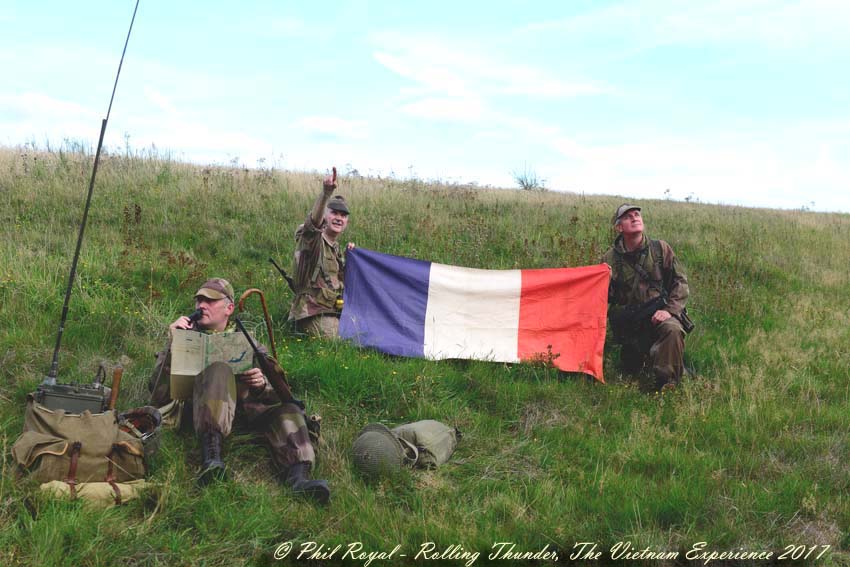
Also a big thank
you to two
friends of mine:
Greg,
from www.modernforces.com
for taking the
role of the
officer
Ian, from
Rolling Thunder
for taking the
role of the NCO
and to Phil
Royal from www.depthoffieldimages.co.uk
for his hard
work during the
photo
shoot,
I am the
Radio in this
photo shoot.
I
decided to use
Phil's photos in
colour to
illustrate the
uniform study
and which are in
keeping
with the few
existing colour photos of
the battle of
Dien Bien Phu.
***
A
second photo
shoot was
orgenised on the
6e BPC this time
with the help of
more
friends,
Darren (NCO) from
French
Army Reenactment
Group
FARG, Ian from
Rolling Thunder
(radio)
and
Bosnia War combat
photographer
Sean Vatcher, (Facebook
Vietnam-báo chí).
I am the officer
in this photo
shoot.
Sean decided to
process all his
photos in black
and white to
recreate that
50's combat
photographer
feel.
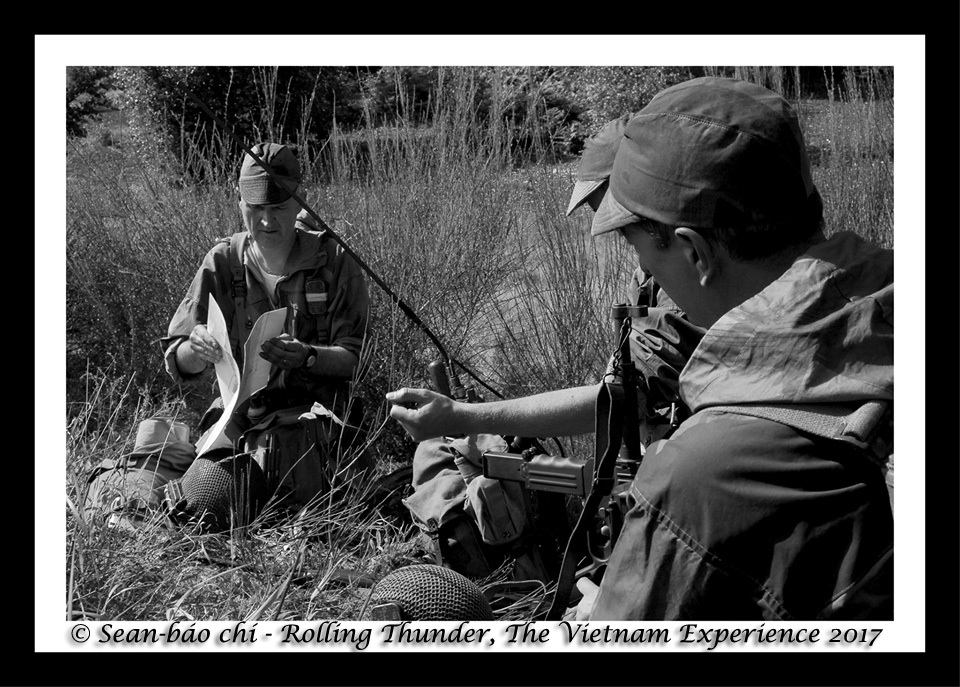
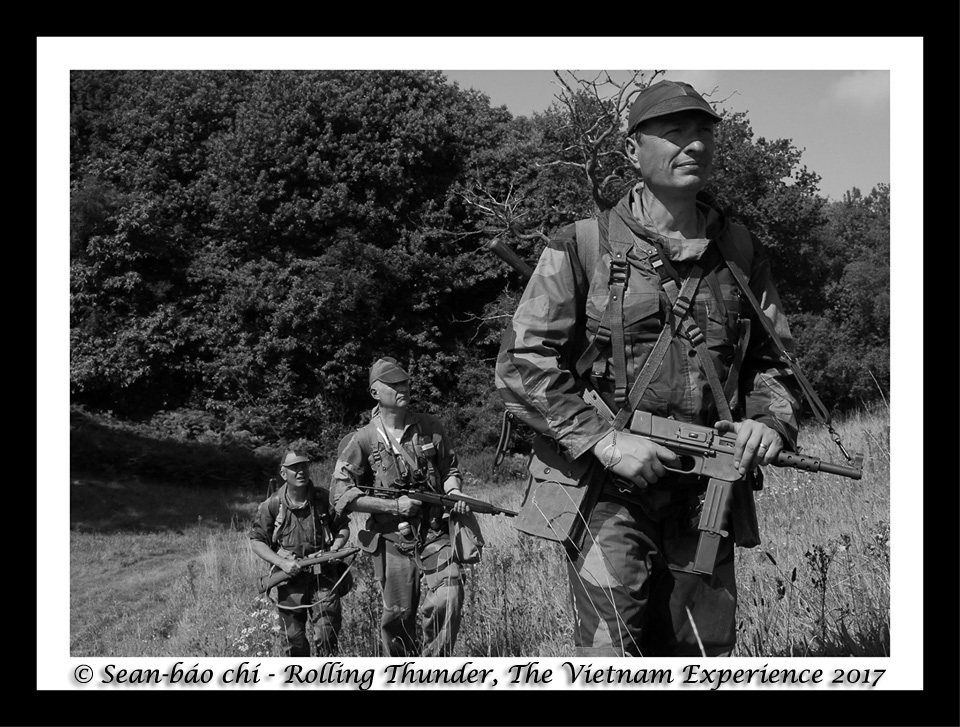
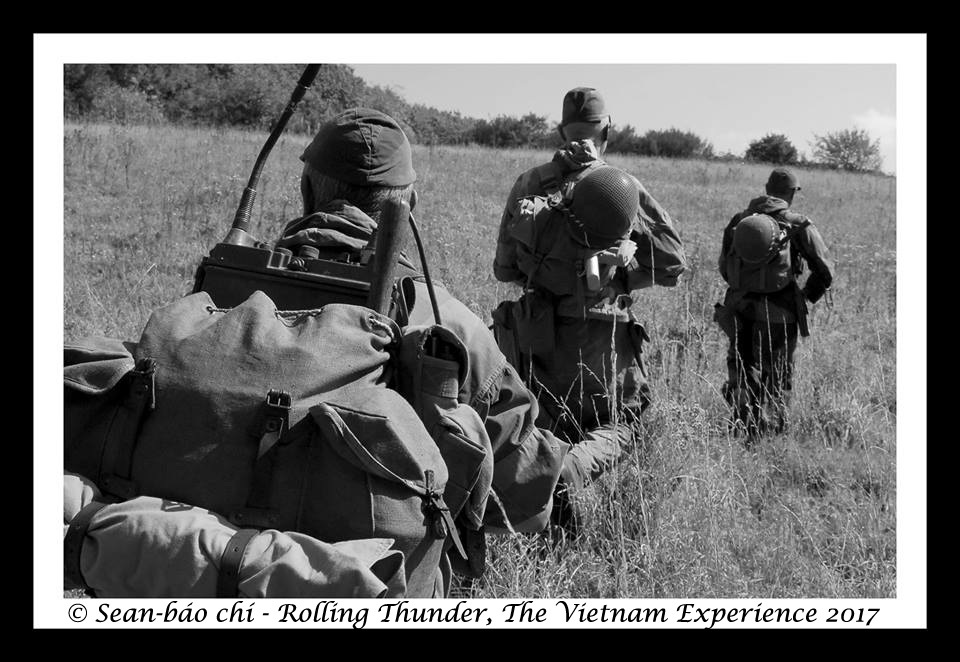
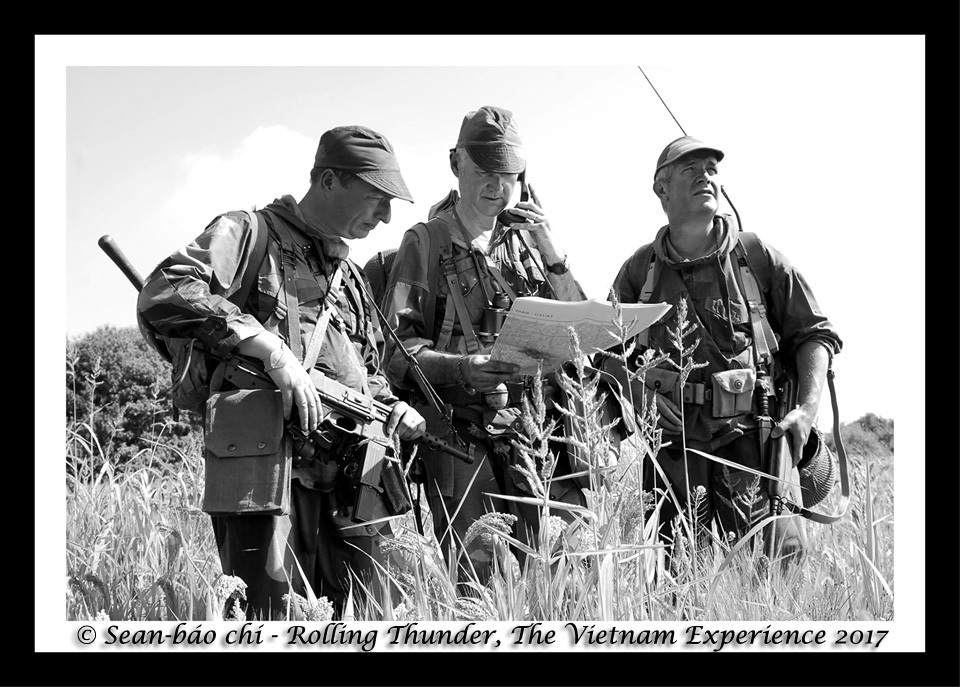
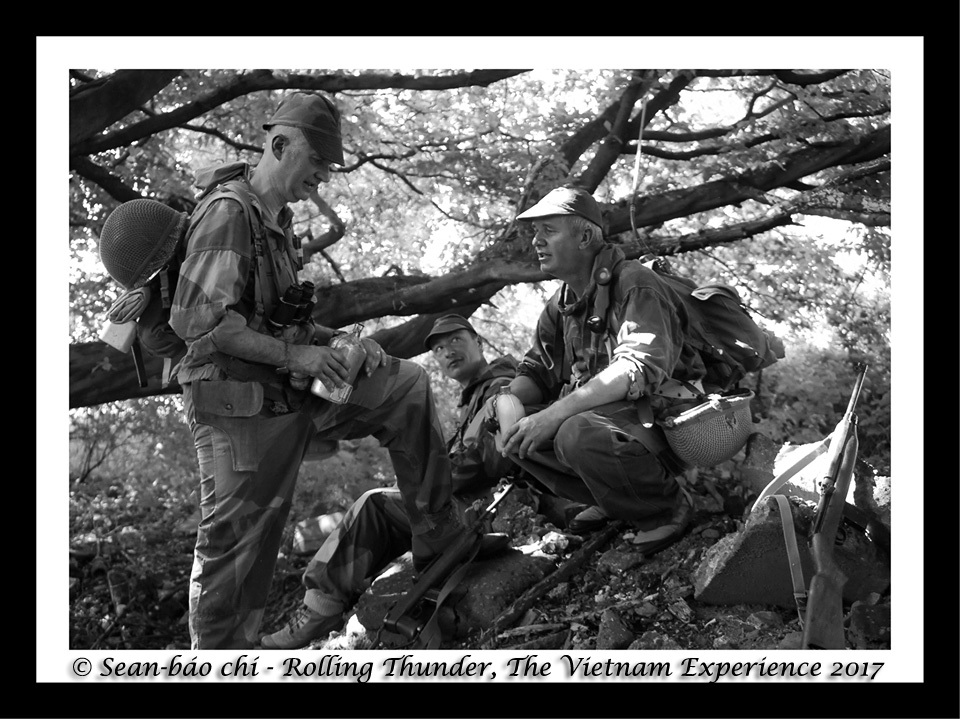
Both Photo shoot
were taken
August 2017 Military
Odyssey show,
Kent, UK.
***
Series
of war time photographs
from the ECPAD
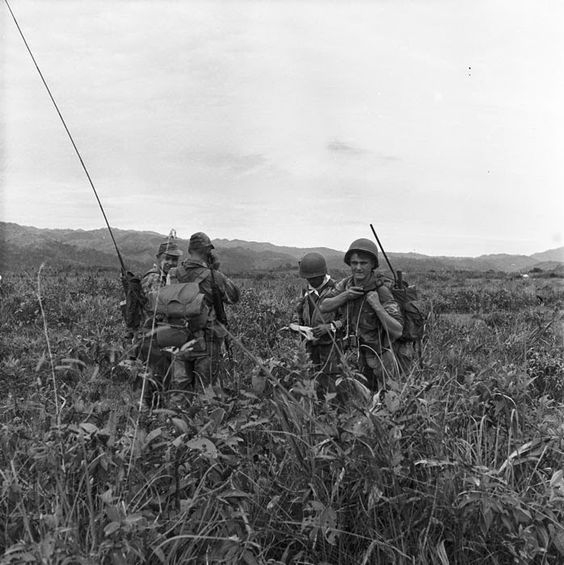
6e
BPC during
"Operation Castor",
November 1953
(you can
also notice an
entrenching tool
on the right
side radio's Bergman
ruck)
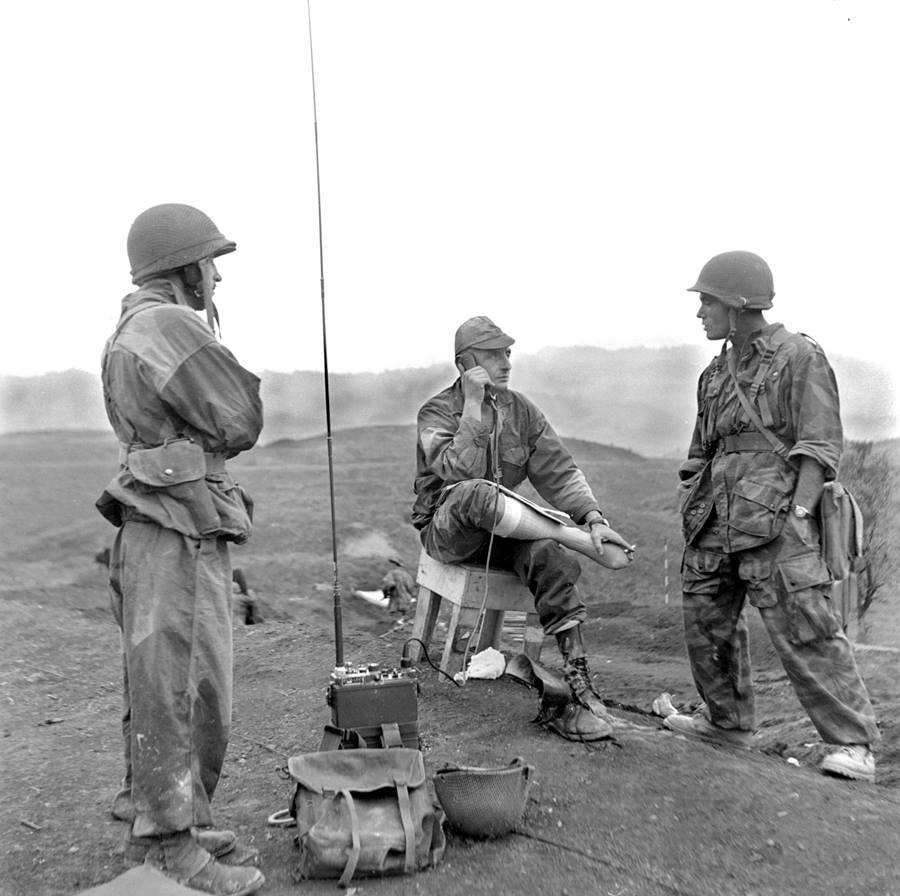
6e
BPC Battalion Commander
Marcel Bigeard
(Code name:
BRUNO) and
Major Bottella
from
the
5e BPVN
(Vietnamese
Parachute
battalion)
Photo taken
after the 2dn
drop in DBP on
the 16 March
1954
.JPG)
DZ Natacha, 6e
BPC, DBP, 20 November 1953
More
photos and info at:
www.ecpad.fr/operation-castor-a-dien-bien-phu-20-24-novembre-1953/
Les images de Diên Biên Phu dans les fonds de l’ECPAD
|
|
|
***
This
uniform study is of the
6th Colonial Paratroop battalion,
which wore the full British Windproof uniform
and mainly
French equipment during Castor
and the battle of DBP.
Uniform
& Equipment description
|
Officer
Full set of
British windproofs, TAP/EO M1
helmet, footwear
is the French M50
jump boots, gear
include the TAP
M50 belt, M50
pistol holster and
suspenders with US
M1 carbine pouch,
TTA M51 water
bottle, US WW map
case. He has the
TAP50 musette with
entrenching
tool, M51 binoculars,
weapons are the
M1A1 carbine, Colt
45 in its TAP M50
holster, US M3
fighting knife and
one OF37 in a
leather grenade
pouch
and DF grenade on
his belt. |
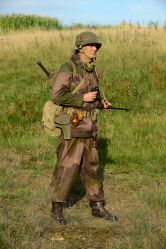 |
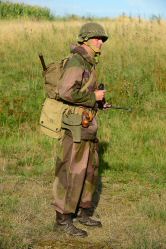 |
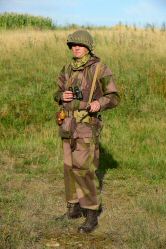 |
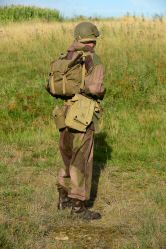 |
|
Radio
Man
Full set of
British windproof
uniform but this
time modified with
the addition of a
full zip, he is
sporting the
6th BPC latest headgear,
"Casquette
Bigeard" and
TAP/EO M1 helmet, footwear
is the French M50
jump boots, gear
include the TAP
M50 belt and
suspenders with US
M1A1 carbine
pouches, TTA M51
water bottle.
A PRC10 radio is
slung in his
Bergam on witch is
attached a M35
tent.
His weapons are the M1A1 carbine,
US M3 fighting
knife and OF and
DF M37
grenades. |
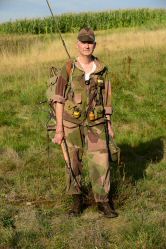 |
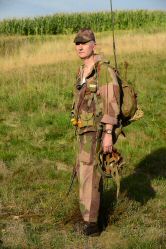 |
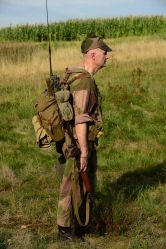 |
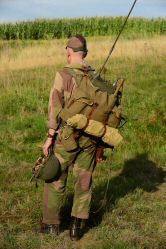 |
|
NCO
Again full set of
British windproofs
, US M1A1 helmet, footwear
is the French
Pataugass jungle
boots, gear
include the US M36
belt and TAP50
suspenders
with
TAP50 MAT 49
pouches, US M1910 water
bottle.
He
has French M35
half tent and a
M35 quart tucked
away under the
flap
of his TAP50
musette.
Weapons are
MAT 49, US M3
fighting knife
and
one French OD37 in
a leather grenade
pouch. |
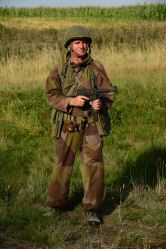 |
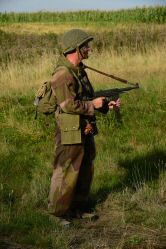 |
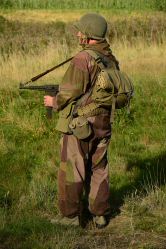 |
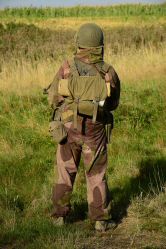 |
Bigeard
Cap:
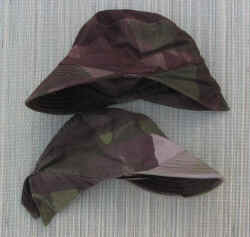
The
Bigeard cap was adopted by
the 6th BPC after the Raid on Lang
Son (July 1953).
The new cap took the form of the WWII Japanese cap but with a two part
triangular neck cover instead of
the rectangular one.
This helped
into the folding of it inside
the cap if not needed.
Several models do exist with
slightly different
constructions, different stitching
on the visor, different
construction neck covers and
caps were lined or unlined.
The Indochina ones were made out
of British Windproof but a few
examples also exist in the US
HBT cammo material.
The same cap saw service during
the Algerian war in
windproof material as well as in
French TAP Lizard
material.
The Bigeard hat has been the traditional
headgear of French Para since
the 60's.
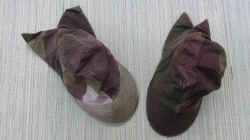
Re-enactors
notes: genuine Indochina war time
Bigeard hats are extremely rare
and do go for a lot of money
if
they can be identified as genuine
war time ones.
The
ones that you do see occasionally
for sale are either Algerian war
or post war manufacturers with
genuine material which were made
when the British Windproof was affordable in the 80's-90's.
I
believe also that some of been
made out of reproduction
material to be sold to
re-enactors,
they can be easily identifiable
as the material feel more silky
to the touch.
Helmets:
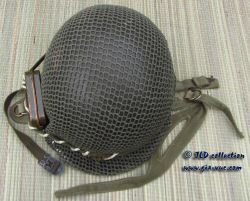
The
Para helmets were either the
WWII US M1c or the US M1 with a
modified liner which had received the TAP/EO Airborne
Indochina modification.
The camo
net was the US WWII
M43 net with its
foliage band. On the photo
above, the band holds a US
WWII Carlisle dressing which was
much preferred due to water
resistance.
The white
cord looped around the foliage
band is a piece of parachute
suspension cord which was used
to secure the helmet
to the webbing during
parachute jumps.
In fact the
TAP/EO modification were not
that strong and sometimes broke
during parachute jumps resulting
with the loss of the
helmet. With the cord, the helmet would
stay suspended to the webbing
to be retrieved once on the
ground.
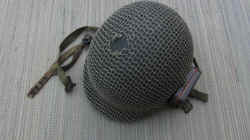
Re-enactors
notes: genuine war time TAP/EO converted
helmets are extremely rare and command very high
prices. Conversion kits and converted
post war M1 helmets are available
from specialised dealers.
Genuine nets are a little more
difficult to obtain but repro
are available. Genuine
bandages are very common.
The jacket
and trousers:
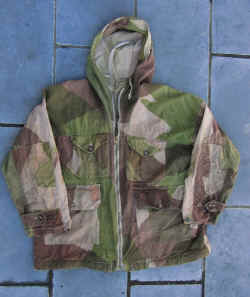
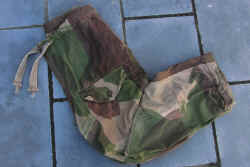
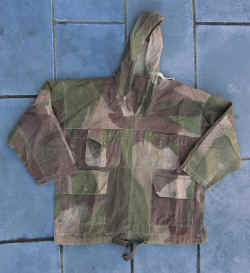
WWII period British Army issue
windproof came in a two-piece
suit:
smock and trousers, the
Windproof Camouflaged Smock was
intended to be worn as an
oversuit over the Battledress.
The pattern of printed
camouflage was unique to this
form of dress and it became
popular with the Special Air
Service and various commando
units.
It is sometime referred
as SAS smock by collectors. This
was know to the French army as
"peau de saucisson"
"sausage skin" due to
it's feel. They were used as
issued or received
modifications:
the
top sometime received an half or
full zip or an opening with
buttons, the hood were sometime
removed and made into a collar,
the trousers were remodeled with
a Zip or button fly and pockets
were some time added.
Re-enactors notes:
Genuine
British War time Windproofs are
commanding high price now,
luckily
fairly good reproductions have
been available for re-enactors and even collectors.
As
far as I am aware, there is 3
manufacturers of them,
Panzerfaust, What Price Glory
and Silverman, the last one been
a poor
replica due to the wrong colour print
and heavy material used.
The
boots:
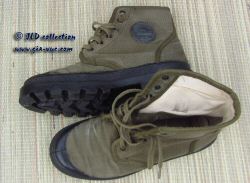
French military jungle boots
"Pataugas" officially started to appear in small numbers around 1948, prior and post that time, soldiers had to rely on civilian or locally made ones. They were light and quick drying and paras often wore them instead of their leather jump boots.
The "Pataugas" is also another characteristic item worn by many soldiers in Indochina from 1950 onwards. The first one issued were from the famous "Bata" brand, but the manufacturing was soon sub contracted to many other manufacturers to fulfill the demand
"BONUSAGE"
brand genuine 50's issue
Pataugass
_tm.jpg) _tm.jpg) _tm.jpg)
Re-enactors
notes: The same pattern was
produced and used by the French
army well into the 1980s so later
models are not that difficult to
obtain. Modern copies are made
by Miltec and by French Surplus
store "La Tranchee
Militaire), Miltec one include
their name and LTM
"Operation Castor" on
the black rubber ankle re-enforcement
making them easy identifiable as
coppies. Beware,
the French army had some post
war Pataugas made with a green
rubber sole and others with a
buckle gaiter section added
(similar to the Rangers).
These
are no good for
Indochina or Algeria.
TAP
Jump boots:
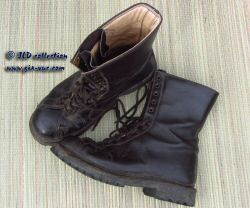
The
French released their own jump
boots in 1950, then a slightly
modified version in 1953.
Detailed photos
_tm.jpg)
_tm.jpg)
Italian copies on the left
and genuine M50/53 jump boots on
the right.
_tm.jpg)
_tm.jpg)
_tm.jpg)
Genuine M50/53 jump boots on
the left and Italian copies on the
right (shiny smooth dark
brown leather)
Re-enactors
notes: these French M50/53 jump
boots are
very rare and expensive to
purchase. For a long time it
has been acceptable for
re-enactors to wear the Italian
para boots which, from the front,
resemble the French model.
The sole and the rear of the
boots are slightly different as
well as the leather used.
What Price
Glory are making very good
reproduction boots to order.
The only
difference is they use a
Vibram sole.
Equipment:
The
6th BPC during Castor and DBP was mainly
equipped with the new TAP 50 and
50/53 French made
equipment
with still a few previously
issued WWII US gear.
 |
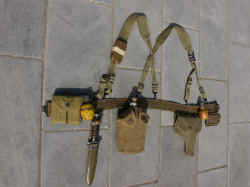
The photos above showing you the
Officer set up,
TAP 50/53 suspenders
with Carlisle bandage, a TAP 50
belt, WWII US M1 carbine pouch,
TTA M51 water bottle, TAP
50 holster with Colt 45 or MAC
50, WWII Airborne compass pouch
and OF and DF M35 French
grenades.
|
 |
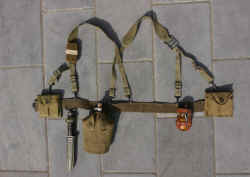
Our
radio man carry virtually the
same set up, minus the compass
and the pistol holster ( which was
standard issued to radio men).
He
opted to take instead a
entrenching tool much more handy
for close combat. Under his
"peau de saucisson"
he his wearing a
sleeveless white sport
shirt, this were favored
to the army issue under vest. |
|
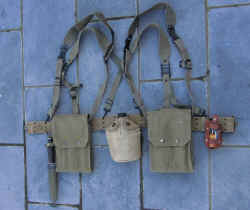
Our
NCO has a mixture of
French and WWII US equipment
with M36 US pistol belt and
M1910 water bottle but TAP 50
suspenders, TAP MAT
49 ammo
pouches, the US M3 fighting
knife and DF M35 grenade in a
leather pouch.
|
Re-enactors
notes: The M50 belt is the one to get,
but is rare.
From the late 50's some M50
belts were manufactured in
Europe or locally for
"Regimental foyer"
which can be
recognised
by the flat metal belt
loop instead of the rounded
type used on the original
Army issue belt. They are a lot
less desirable.
Buyers must be aware that fake
M50 belts have been made from
the French M50/53 belt webbing
with 50's
British web belt buckle
and the flat belt loop.
The M36 US WWII web belt would
still have been common with the
6th BPC.
The rest of the equipment can be
easily obtained via the
internet, except for the TAP musette
which is rarer.
A genuine M3
knives are expensive, but good repros do exist.
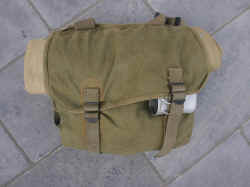
The
NCO and Officer carry the TAP 50
musette/haversack.
This one has a French M35 light khaki
half tent rolled
under the flap and you can just about see a M35 quart tied down to one of the
strap.
Special
notes "Information
obtained from Philippe Fabre
whose father served with the
I/II RCP at Dien Bien Phu.
French Para always traveled
light and would usually carry in
their "musette", a jumper,
a spare pair of socks and
underpants, half a shelter
tent, a ration and a
couple of emergency rations (to
open only under order) and loads
of ammo.
No mast or pegs for their
half tent. For water a single water
bottle with some purification
tablets.
Philippe's
father was a radio repair man
and carried a lot of radio spare
for the Battalion in a Bergam
rucksack, on the first combat
operation he did, he took a
MAT49 and a couple mag pouches
(10 mags) plus loose ammo, as
this was too heavy on his second
one he took a 45 and found out
that this was a little light,
then he settle down for an M1A1
carbine, 3 mags and loose ammo
in bulk. He said that on
operations, they was a shortage
of everything except ammunition.
To the unusual comment I made
that in most photos I have seen,
the French paras on operation in
Indochina
always appear to be well shaven
despite having only one water
canteen,
he said that
they shaved
every morning
because drinking water was
not required for a shave and he
added that
Bigeard
said "At
the 6th, we die well shaven
because it is not pleasant to
shave a corpse"
The Radio man opted for the
French TTA Bergam, to carry his
extra load.
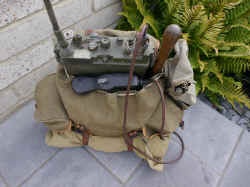
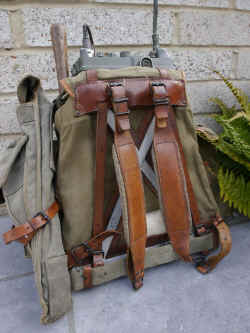
Both
French model 1935 and 1951 tents
were issued in Indochina.
The Para mainly used the M35 or
some US WWII 2 men tent
"Tent Shelter Half) when available as the cotton was more
waterproof that the French ones.
Both French models had a slit
with buttons to be used as a
poncho.
The French Paras did not carry the poles
and pegs with them and used
branches or
bamboo
to set them up when ever needed.
The M35 is designed once
assembled to sleep 6 soldiers,
with four sections for the two
sides
and one each for front and back,
each individual section of the
tent is 1.6m . These of course
were often used as pairs to
sleep two men.
M35
tents
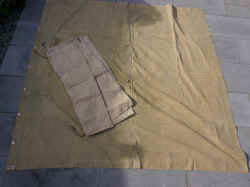
Re-enactors
notes: In 1956 (post
Indochina), a new tent was
introduced, the M56 (1956)
which was a copy of the US Tent
(Tent Shelter Half) to sleep two
men.
The
weapon:
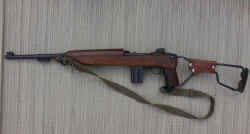
US
M1A1 carbine (folding
stock) were issued to Officers
and many radio men also carry
them.
Standard M1 carbines were
sometime seen in Airborne
battalion, M1 and M1A1 with or
without bayonet lug were used.
The M1A1 carbine was well liked
by the Para for it compactness
and lightness, more ammunitions
could also be carried, but the
30 Carbine caliber, with its
1990 fps muzzle velocity
lacked a little in punch and
penetration specially in jungle
environment.
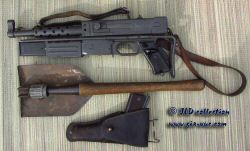
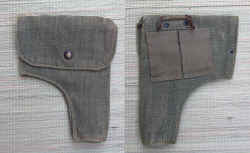
The
MAT 49, iconic weapons of the
French army started to appear in
Indochina during 1950.
The 9mm
MAT
49 SMG was an excellent weapon for close
combat with a 32 round mag which
folds
under for transport.
In the photo above is also a US WWII entrenching tool and a
Colt 45 in a Vietnamese made
holster, the other photo is of
the TAP pistol holster, this is
the rare model M1950, the 1953
model will receive
re-enforcement rivets.
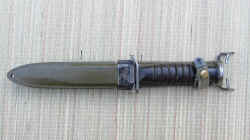
Standard
US M3 fighting knife, the most common
type of fighting knife found in
the French Para units in
Indochina.
Re-enactors
notes: A genuine M3
knives are expensive, but good repros do exist.
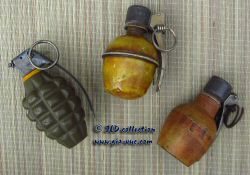
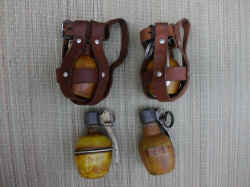
US MKII pineapple
grenade, French OF37 and DF37
grenades and
a couple of the French leather
grenade pouches used in
Indochina.
Re-enactors
notes:
MAT
49 and OF/DF37 are
rare and difficult to obtain
here in the UK.
Map
Case:
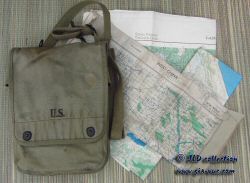
Standard WWII US Army
map case with genuine Indochina
maps.
Re-enactors notes: maps are a little
more difficult to obtain than a genuine issue map case,
which are
to be preferred to repro ones.
Locally-made as well as German and
British map cases were also used.
Binoculars:
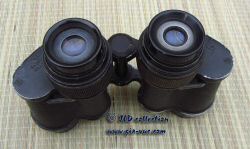
French issue 8x30 M51.
Those used in the photo shoot were
1944 Canadian ones.
WWII British,
US and German ones were also used in
Indochina
***
Please
note the equipment and uniforms
described here are time specific for
the 6th BPC.
For
instance,
some of their uniforms and equipment
would have been different
during the fighting at Tu Le in
1952.
***
Here is the list of our requirements
for that specific photo shoot.
Helmet
US M1C or M1 modified TAP
US
1944 pattern camo net with or
without band
Bigeard cap
WWII
British Windproof uniform
French
M50 - M50/53 jump boots (Italian
para boots) or Pataugas (jungle
boots)
Equipment
M50
TAP or M36 US belt
TAP
M50 or M53 suspenders
French
M47 or US WWII M1910
water bottle
MAT
49 and TAP
ammo pouches,
or
M1A1 carbine with US M1 twin cell
pouch, or French M50, or M50/53
riffle ammo pouch.
TAP
M50 Para musette bag
TTA
French Bergam rucksack
US
WWII entrenching tool
WWII
parachute silk scarf ,
camo or white (NOT
RIPSTOP)
French
or US WWII Carlisle field dressing (in
metal can)
M3
fighting knife
OF
and DF French grenade, or US Pineapple
grenade
TAP50
holster, or US or M48 French
leather holster
French
or US M32 medic pouch
PRC10,
SRC536, BC-1000 radio
M51
French binoculars or WWII US,
British or German
FM24/29
with TAP 50/53 ammo pouch
M35
light khaki rectangular half
shelter tent
***
Điện
Biên Phủ
|
These
following leaflets have
been translated in
English by myself to
illustrate the fate of
French prisoner in
Indochina.
The original ones were
produced by the National
Association of former
prisoners and
deportees of Indochina.
http://www.anapi.asso.fr/ |
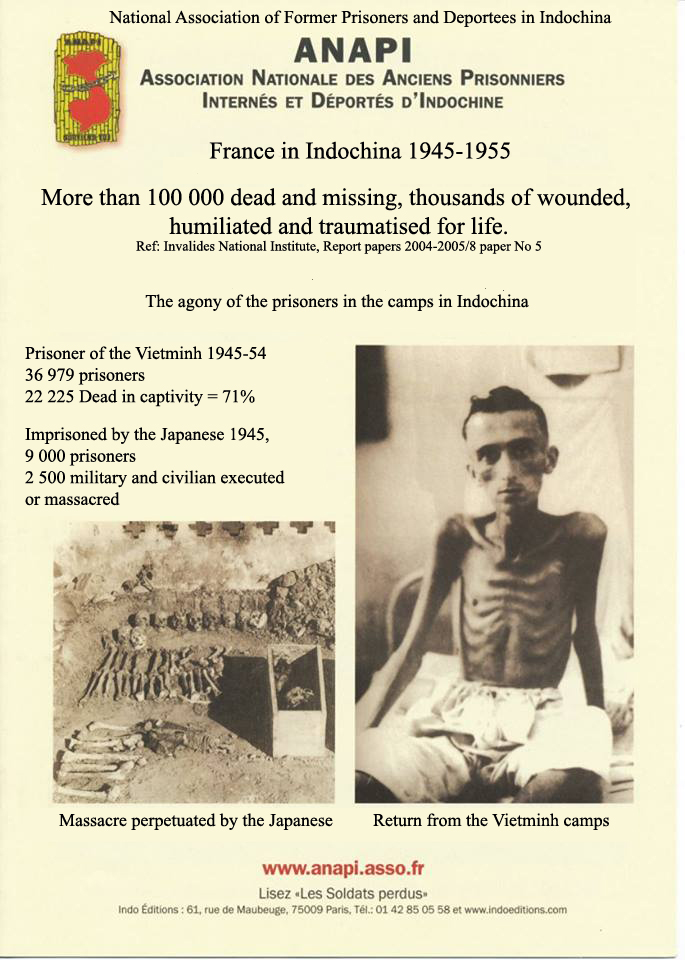
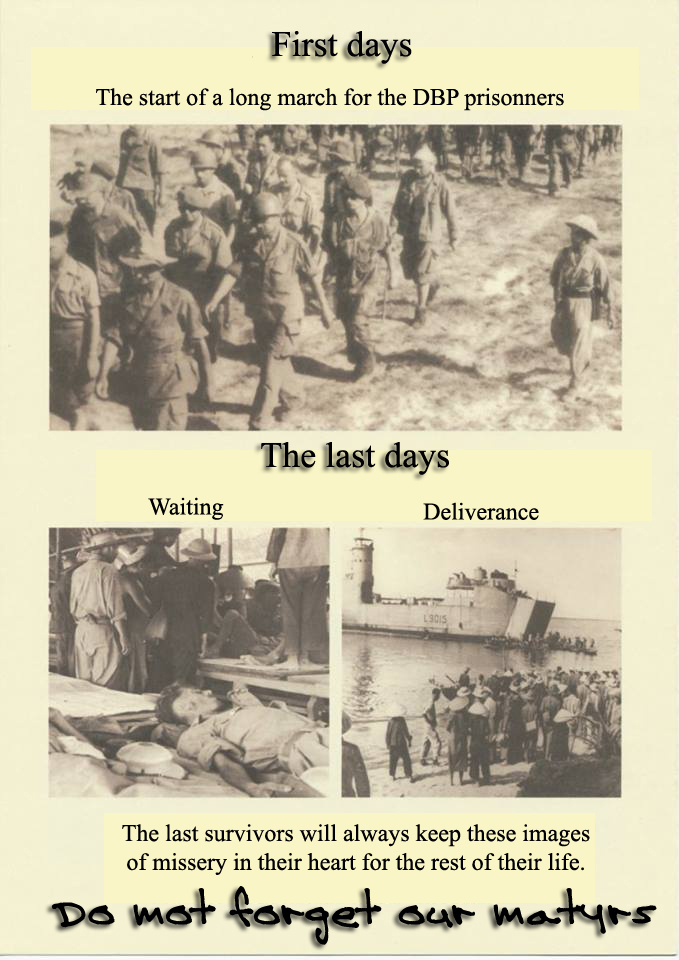
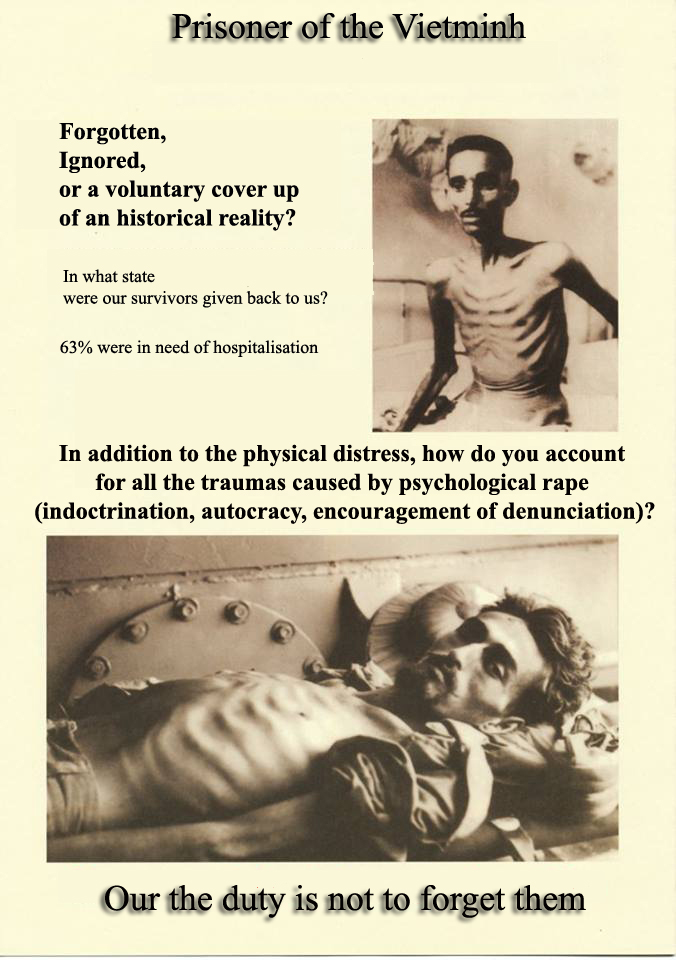
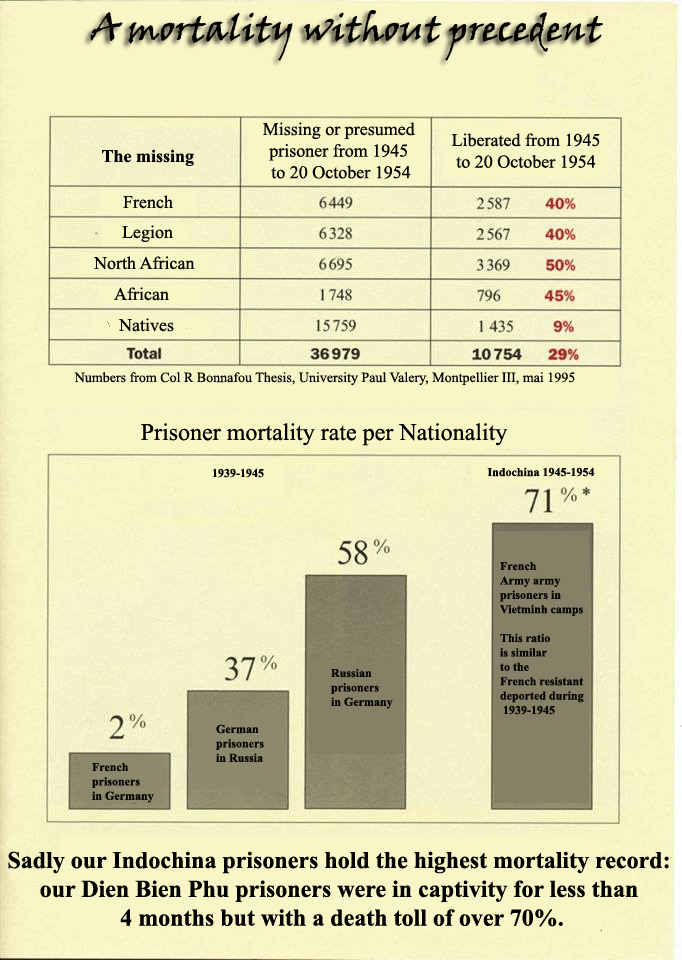
Dien Bien
Phu prisoners

Photo
from Google search, taken by
Russian photographer
It would not be an
exaggeration to say that the
Viet Minh prison camps in
Indochina were
equal if not worse than the German or
Soviet prison camps during
World War II.
One in four Dien Bien
Phu prisoners will not return
alive from their four months in
captivity.
The Viet Minh captured 11,721
men. The badly-wounded were
looked after by the
Red Cross. The remaining 10,863
were taken as prisoners. Only
3,290 of them were repatriated.
Also, there is no record as to what
happened to the Indochinese who
helped and fought with the French
during the battle.
***
Some
more data from an article from
French Maj Turellier
who spent 5 years 6 months as a prisoner of the
Viet Minh
A
total of around 36,979
prisoners were taken by the
Viet Minh during the war.
10,
754 were released and 26,225
died in camps or on the
roads, which amounts to 71%
of deaths .
The
DBP prisoners mortality rate
was, on average, 72% in four
months.
The
Viet Minh prisoner camps
numbers 42 and 113 were the
most deadly. They were
simply
extermination
camps, a grim reminder of
the WWII German camps.
At
camp number 42, out of 400
Dien Bien Phu prisoners,
only 73
came
out after four months.
That equates to 82% of
deaths.
Article/Study
in French byMaj Turellier -
pdf download link below
http://www.atdm34.net/images/stories/souvenirs/Maj_Turelier.pdf
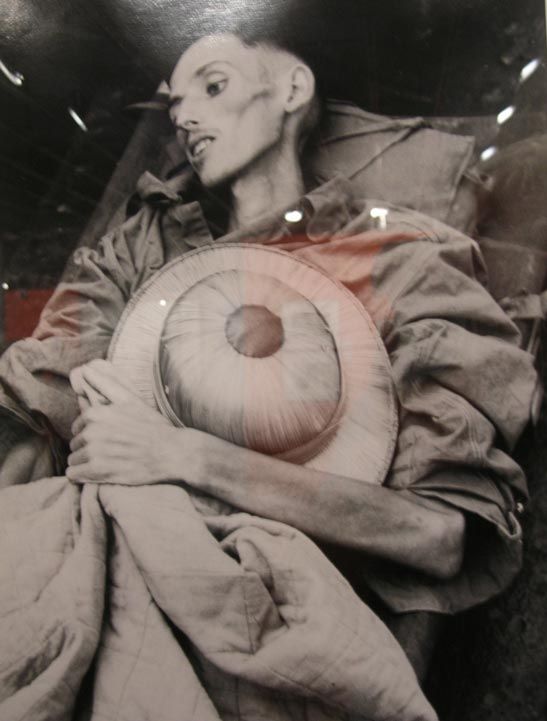
Photo
from Pinterest, author unknown
|